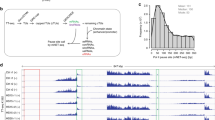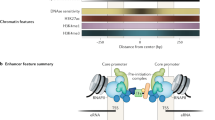Abstract
Transcription is a critical component in the expression of genes. Here we describe the design and analysis of a potent core promoter, termed super core promoter 1 (SCP1), which directs high amounts of transcription by RNA polymerase II in metazoans. SCP1 contains four core promoter motifs—the TATA box, initiator (Inr), motif ten element (MTE) and downstream promoter element (DPE)—in a single promoter, and is distinctly stronger than the cytomegalovirus (CMV) IE1 and adenovirus major late (AdML) core promoters both in vitro and in vivo. Each of the four core promoter motifs is needed for full SCP1 activity. SCP1 is bound efficiently by TFIID and exhibits a high propensity to form productive transcription complexes. SCP1 and related super core promoters (SCPs) with multiple core promoter motifs will be useful for the biophysical analysis of TFIID binding to DNA, the biochemical investigation of the transcription process and the enhancement of gene expression in cells.
This is a preview of subscription content, access via your institution
Access options
Subscribe to this journal
Receive 12 print issues and online access
$259.00 per year
only $21.58 per issue
Buy this article
- Purchase on Springer Link
- Instant access to full article PDF
Prices may be subject to local taxes which are calculated during checkout






Similar content being viewed by others
References
Smale, S.T. Core promoters: active contributors to combinatorial gene regulation. Genes Dev. 15, 2503–2508 (2001).
Butler, J.E.F. & Kadonaga, J.T. The RNA polymerase II core promoter: a key component in the regulation of gene expression. Genes Dev. 16, 2583–2592 (2002).
Hochheimer, A. & Tjian, R. Diversified transcription initiation complexes expand promoter selectivity and tissue-specific gene expression. Genes Dev. 17, 1309–1320 (2003).
Smale, S.T. & Kadonaga, J.T. The RNA polymerase II core promoter. Annu. Rev. Biochem. 72, 449–479 (2003).
Bajic, V.B., Choudhary, V. & Hock, C.K. Content analysis of the core promoter region of human genes. In Silico Biol. 4, 109–125 (2004).
Gershenzon, N.I. & Ioshikhes, I.P. Synergy of human Pol II core promoter elements revealed by statistical sequence analysis. Bioinformatics 21, 1295–1300 (2005).
Kim, T.H. et al. A high-resolution map of active promoters in the human genome. Nature 436, 876–880 (2005).
Ohtsuki, S., Levine, M. & Cai, H.N. Different core promoters possess distinct regulatory activities in the Drosophila embryo. Genes Dev. 12, 547–556 (1998).
Butler, J.E.F. & Kadonaga, J.T. Enhancer-promoter specificity mediated by DPE or TATA core promoter motifs. Genes Dev. 15, 2515–2519 (2001).
Emami, K.H., Navarre, W.W. & Smale, S.T. Core promoter specificities of the Sp1 and VP16 transcriptional activation domains. Mol. Cell. Biol. 15, 5906–5916 (1995).
Garraway, I.P., Semple, K. & Smale, S.T. Transcription of the lymphocyte-specific terminal deoxynucleotidyltransferase gene requires a specific core promoter structure. Proc. Natl. Acad. Sci. USA 93, 4336–4341 (1996).
Lim, C.Y. et al. The MTE, a new core promoter element for transcription by RNA polymerase II. Genes Dev. 18, 1606–1617 (2004).
Lagrange, T., Kapanidis, A.N., Tang, H., Reinberg, D. & Ebright, R.H. New core promoter element in RNA polymerase II-dependent transcription: sequence-specific DNA binding by transcription factor IIB. Genes Dev. 12, 34–44 (1998).
Evans, R., Fairley, J.A. & Roberts, S.G. Activator-mediated disruption of sequence-specific DNA contacts by the general transcription factor TFIIB. Genes Dev. 15, 2945–2949 (2001).
Deng, W. & Roberts, S.G. A core promoter element downstream of the TATA box that is recognized by TFIIB. Genes Dev. 19, 2418–2423 (2005).
Hawley, D.K. & Roeder, R.G. Separation and partial characterization of three functional steps in transcription initiation by human RNA polymerase II. J. Biol. Chem. 260, 8163–8172 (1985).
Hawley, D.K. & Roeder, R.G. Functional steps in transcription initiation and reinitiation from the major late promoter in a HeLa nuclear extract. J. Biol. Chem. 262, 3452–3461 (1987).
Kadonaga, J.T. Assembly and disassembly of the Drosophila RNA polymerase II complex during transcription. J. Biol. Chem. 265, 2624–2631 (1990).
Kokubo, T., Yamashita, S., Horikoshi, M., Roeder, R.G. & Nakatani, Y. Interaction between the N-terminal domain of the 230-kDa subunit and the TATA box-binding subunit of TFIID negatively regulates TATA-box binding. Proc. Natl. Acad. Sci. USA 91, 3520–3524 (1994).
Thompson, J.F., Hayes, L.S. & Lloyd, D.B. Modulation of firefly luciferase stability and impact on studies of gene regulation. Gene 103, 171–177 (1991).
Dignam, J.D., Lebovitz, R.M. & Roeder, R.G. Accurate transcription initiation by RNA polymerase II in a soluble extract from isolated mammalian nuclei. Nucleic Acids Res. 11, 1475–1489 (1983).
Acknowledgements
We are grateful to C.Y. Lim, J.-Y. Hsu and D. Urwin for advice throughout this study. We thank J.-Y. Hsu, T. Yusufzai, B. Rattner, D. Urwin, D. Fyodorov, J. Theisen, T. Bretz and C.Y. Lim for critical reading of the manuscript. We thank C. Inouye and R. Tjian for providing the purified human TFIID, C.Y. Lim for the purified D. melanogaster TFIID, J.-Y. Hsu for the pGL3-Basic vector with a modified polylinker, E.-T. Wong and G. Wahl for the pOG33-SV40 β-gal cotransfection plasmid, and W. Cavenee and F. Furnari for the use of their luminometer. This work was supported by a grant from the US National Institutes of Health (GM041249) to J.T.K.
Author information
Authors and Affiliations
Contributions
J.T.K. and T.J.-G. conceived the experimental design. T.J.-G. performed the experiments. S.C. prepared the HeLa nuclear extracts and generated the SCP1, CMV and AdML −36 to +45 core promoter pUC119 constructs used in the experiments in Figure 1. T.J.-G. and J.T.K. wrote the manuscript.
Corresponding author
Ethics declarations
Competing interests
A patent application covering the work described in this article has been filed by The Regents of the University of California. Although the authors do not have a personal conflict of interest, the authors' employer, The Regents of the University of California, could potentially gain financially from the publication of the studies described in this work.
Supplementary information
Supplementary Fig. 1
SCP1 is transcribed more efficiently than the CMV or AdML core promoters. (PDF 213 kb)
Supplementary Fig. 2
Analysis of the binding of purified human TFIID to SCP1 as well as to SCP1 variants that contain mutations in the TATA box, Inr, MTE, or DPE. (PDF 270 kb)
Supplementary Fig. 3
SCP1 is more active than the CMV or AdML core promoters in Chinese hamster ovary (CHO) cells. (PDF 85 kb)
Supplementary Fig. 4
SCP1 is more active than SCP2 in the absence of an enhancer as well as with the SV40 enhancer. (PDF 87 kb)
Rights and permissions
About this article
Cite this article
Juven-Gershon, T., Cheng, S. & Kadonaga, J. Rational design of a super core promoter that enhances gene expression. Nat Methods 3, 917–922 (2006). https://doi.org/10.1038/nmeth937
Received:
Accepted:
Published:
Issue Date:
DOI: https://doi.org/10.1038/nmeth937
This article is cited by
-
Using Synthetic DNA Libraries to Investigate Chromatin and Gene Regulation
Chromosoma (2023)
-
Development of a stable antibody production system utilizing an Hspa5 promoter in CHO cells
Scientific Reports (2022)
-
Cytosine base editing systems with minimized off-target effect and molecular size
Nature Communications (2022)
-
Engineering domain-inlaid SaCas9 adenine base editors with reduced RNA off-targets and increased on-target DNA editing
Nature Communications (2020)
-
Towards a comprehensive catalogue of validated and target-linked human enhancers
Nature Reviews Genetics (2020)



